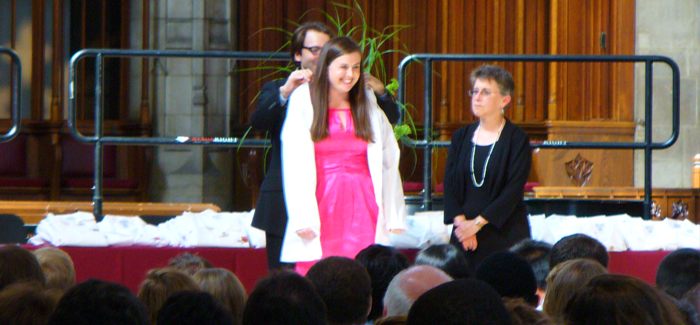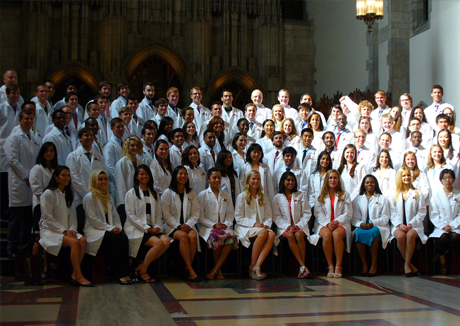
(Photography by Maureen Searcy)
First-year medical students receive the symbol of the alliance between science and personal care.
In August the Pritzker School of Medicine held its annual White Coat Ceremony, welcoming 88 incoming students by presenting them with their first white coat.
Rockefeller Memorial Chapel’s dark wood and red velvet pews were filled with family, friends, and mentors, whispering or silently waiting. Late afternoon sunlight streamed through stained glass, casting jewel tones on arms and shoes. Suddenly an orchestral march thundered through the hall, and all bodies swiveled to watch a line of beaming students file in from the back.
The students took their seats in the front pews. After several opening remarks, keynote speaker professor Mark Siegler, MD’67, approached the podium. He spoke on a variety of topics, from the Nobel Prizes of UChicago’s faculty to the Affordable Care Act and how it will affect the medical profession. What stood out to me was his discussion of the false dichotomy between science and personal care. “They are not in opposition,” he said. “In fact, they are two parts of the same commitment to our patients.”
This marriage between care and science is why the white coat became a symbol for the medical profession. In the mid to late 1800s, science was making revolutionary strides in human health-related research and began to merge with medicine, which previously had been focused on personal care. For instance, in 1847 Hungarian physician Ignaz Semmelweiss determined that hospital fatalities were dramatically reduced with the simple policy that doctors wash their hands and change their coats between patients, though he didn’t know why. But 15 years later, chemist and microbiologist Louis Pasteur began testing and refining a germ theory that explained how illnesses spread through hospitals. His research eventually gave us vaccines and longer-lasting milk, and it also directly led surgeon Joseph Lister to develop antiseptic methodology.
To symbolize this new alliance between science and health care, physicians adopted scientific lab coats, in the process changing them from beige to white to further indicate cleanliness, hope, and compassion. Today these white coats help physicians remember the responsibilities of their profession and represent medical students’ acceptance of those responsibilities for the first time.

After Siegler finished his speech, the students were called to the stage one by one where their future teachers helped them into their white coats. Some were cloaked smoothly while others were an awkward tangle of arms and sleeves. One young man struck a pose in his coat, prompting a ripple of laughs through the audience.
At the end of the ceremony, the students stood and faced the crowd to take the Physician’s Oath, a modified and modernized Hippocratic Oath. Physicians in the audience were invited to also rise and take the oath. The phrase “do no harm” is known to many, but the less familiar line preceding it makes the science-care commitment clear. The new and experienced physicians made their pledge:
May I never see in my patient anything but a fellow human in pain. My goal will be to help, or at least do no harm.
